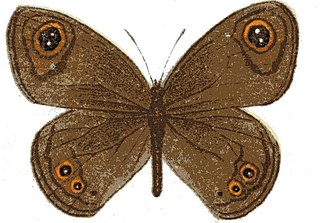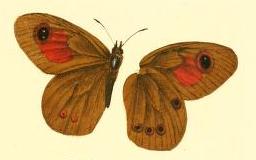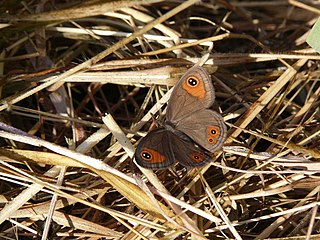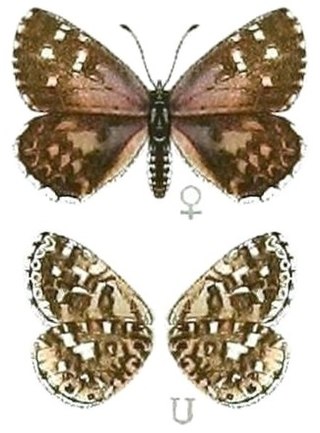
Lachnocnema, commonly called woolly legs, is a genus of butterflies in the family Lycaenidae found mainly in Sub-Saharan Africa. Identification requires dissection to reveal subtle genital distinctions.
Lachnocnema durbani, the D'Urban's woolly legs, is a butterfly of the family Lycaenidae. It is found from Cape Point and KwaZulu-Natal to Mozambique to Kenya, Malawi, Tanzania, and Uganda. The habitat consists of grassy areas in savanna.
Kedestes niveostriga, the dark ranger or dark skipper, is a butterfly of the family Hesperiidae. It is only known from the Cederberg mountains in the Western Cape.

Aeropetes is a monotypic butterfly genus in the family Nymphalidae. Its only species, Aeropetes tulbaghia, is commonly known as the Table Mountain beauty or mountain pride. It is native to southern Africa, where it occurs in South Africa, Lesotho, Eswatini and Zimbabwe.

Neita is a genus of butterflies from the subfamily Satyrinae in the family Nymphalidae.

Neita neita, the Neita brown, is a butterfly of the family Nymphalidae. It is found in South Africa in several isolated populations in grassland and grassy savanna covered hillsides from Eastern Cape into KwaZulu-Natal, Swaziland, Mpumalanga, Limpopo and North West.
Neita lotenia, the Loteni brown, is a butterfly of the family Nymphalidae. It is found in South Africa on grassy mountain slopes on high altitude grasslands along the southern and south-eastern KwaZulu-Natal and Lesotho part of the Drakensberg.

Neita extensa, is a butterfly of the family Nymphalidae. It is found in South Africa from Mpumalanga to Limpopo and further north to Zimbabwe.

Pseudonympha hippia, or Burchell's brown, is a butterfly of the family Nymphalidae. It is found in South Africa on cool high altitude fynbos covered hills and summits from the Cape Peninsula to the Hottentots Holland Mountains, then along the Riviersonderend Mountains to the Groot Winterhoek.
Pseudonympha southeyi, or Southey's brown, is a butterfly of the family Nymphalidae. It is found in South Africa.

Stygionympha vigilans, the western hillside brown, is a butterfly of the family Nymphalidae. It is found in South Africa on the seaward side of the mountains from Cederberg south to the Cape Peninsula in the Western Cape and along the Drakensberg mountains to Grahamstown in the Eastern Cape.
Stygionympha scotina, the eastern hillside brown, is a butterfly of the family Nymphalidae. It is found in South Africa on the seaward side of the mountains from Cederberg south to the Cape Peninsula in Western Cape and along the Drakensberg mountains to Grahamstown in Eastern Cape.
Tsitana tulbagha, the Tulbagh sylph, is a butterfly of the family Hesperiidae. It is found in South Africa. The habitat consists of grassy, rocky areas in fynbos and Karoo.

Durbaniopsis saga, the Boland rocksitter, is a butterfly of the family Lycaenidae. It is found in South Africa in a wide area in the inland of the Western Cape and Northern Cape mountains, from the Nieuwoudtville mountains south to the Cederberg, Koue Bokkeveld, the Hex River and the Hawequas mountains. It is also present on low altitudes from Lambert's Bay inland to Het Kruis.

Capys alphaeus, the protea scarlet or orange-banded protea, is a butterfly of the family Lycaenidae. It is found in South Africa.

Aloeides pallida, the giant copper, is a butterfly of the family Lycaenidae. It is found in South Africa.

Tarucus thespis, the fynbos blue or vivid blue, is a butterfly of the family Lycaenidae. It is found in South Africa, from the Northern Cape, south to fynbos in the West Cape and east to the Amathole Mountains in the Eastern Cape.
Lepidochrysops variabilis, the variable blue, is a butterfly of the family Lycaenidae. It is found in South Africa, from the Cape Peninsula, inland along the western mountains to southern Namaqualand, along the eastern Drakensberg to the Eastern Cape, KwaZulu-Natal, the Free State, Lesotho, Mpumalanga, the southern Limpopo, then west to the central Limpopo, North West and the hills of Gauteng. It is also found in eastern Zimbabwe.
Lepidochrysops oreas, the peninsula blue, is a butterfly of the family Lycaenidae. It is found in South Africa, where it found in fynbos on the Swartberg range from the Eastern Cape to Seweweekspoort and Klein Swartberg in the Western Cape. It is also found on the Rooiberg.

Empisini Nature Reserve was established in 1973 and is situated in Umkomaas, KwaZulu-Natal, South Africa. The reserve is approximately 60 ha in extent and is owned by the borough of uMkhomanzi which has been incorporated into the eThekwini municipality. Empisini is managed jointly by eThekwini and the Umkomaas centre of the Wildlife and Environment Society of South Africa. Empisini takes its name from a perennial stream which flows through it, and means "Place of the Hyena" in isiZulu. The reserve consists of coastal forest, wetlands, grassy slopes and a dam. Infrastructure consists of hiking trails, demarcated picnic sites, overnight cabins, and a tree house.










